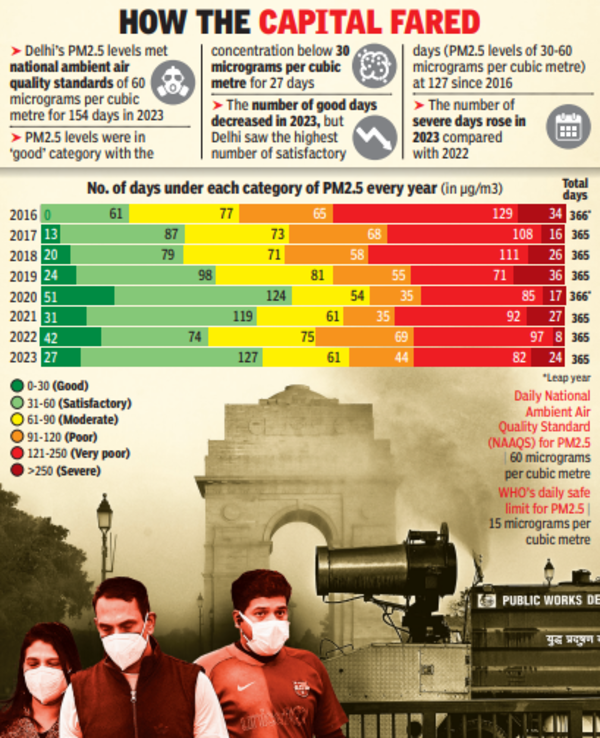The PM2.5 levels were in the ‘good’ category with the concentration below 30 micrograms per cubic metre on 27 days in 2023. This was, however, fewer than the number of ‘good’ days in the previous years. Yet last year, Delhi also recorded the highest number of ‘satisfactory’ days (PM2.5 levels of 30-60 micrograms per cubic metre) at 127 since 2016. Delhi had 74 ‘satisfactory’ days in 2022, 119 in 2021, 124 in 2020, 98 in 2019, 79 in 2018, 87 in 2017 and 61 in 2016, according to CREA.

There were more ‘severe’ pollution days last year than in 2022. In 2023, there were 24 ‘severe’ days (PM2.5 concentration above 250 micrograms per cubic metre) against eight such days in 2022. The highest number of ‘severe’ days was recorded in 2019 at 36.
The CREA analysis showed that the PM2.5 concentration was below 30 micrograms per cubic metre on 27 days in 2023 against 42 in 2022 and 31 in 2021. The lockdown year of 2020 recorded the highest at 51 such days.
Track the pollution level in your city
The annual PM2.5 concentration in 2023 was 101 micrograms per cubic metre, which is more than the 98 of 2022. Both were much higher than the NAAQS which is 40 micrograms per cubic metre. WHO’s annual safe limit for PM2.5 is 5 micrograms per cubic metre. The annual PM2.5 concentration was 104 microgram per cubic metre in 2021, 94 in 2020 and 108 in 2019.
Sunil Dahiya, analyst, CREA, said, “The number of days with PM2.5 levels meeting the NAAQS mark have increased slightly though the average pollution levels and preponderance of ‘very poor’ and ‘severe’ days indicated that apart from the relatively cleaner monsoon period, Delhiites still breathe in hazardous air. Consistent high pollution levels indicate that despite implementing BS VI emission norms and creating the National Clean Air Programme, in the absence of actual emission load reduction-based targets, the agencies responsible have failed to achieve efficient pollution reduction.”
2023 saw the second lowest AQI of 204 after 2020, when it was 185, according to the Commission for Air Quality Management. Barring 2020, 2023 had the best daily average AQI in five years between 2018 and 2023 in March, April, June and July and the second-best average in January, February and May.